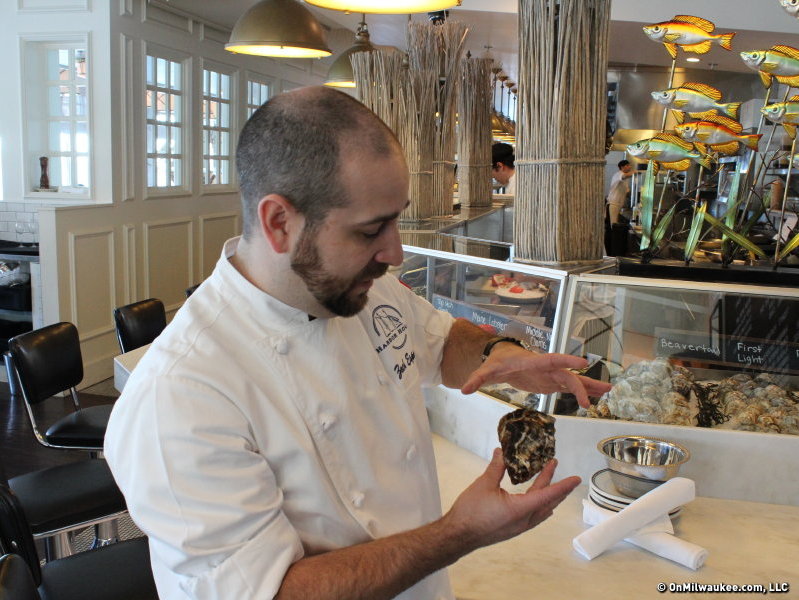Like so many of us, oysters respond to cooling autumn temperatures by bulking up. They do so by building up their stores of glycogen, the carbohydrate layer of the mollusk that that gives them the silky sweet flavor that makes oyster-lovers out of even the most unsuspecting consumers.
So, if you haven’t tried oysters before, it’s a good time to give them a try. There are a number of places around town to try them out, including Maxie’s, which offers daily happy hour specials on the briny treats, and the oyster bar at St. Paul Fish Company in the Milwaukee Public Market, along with Molly Cool’s Seafood Tavern and Barnacle Buds.
But during the week of Oct. 7-13, you’d be smart to get yourself down to Oysterfest at Harbor House where there will be plenty of opportunities for everyone – from novice to connoisseur – to enjoy these oceanic delicacies.
Harbor House sells more than 10,000 oysters every month, and with good reason.
Oysters are delicious. Some have notes of citrus or fruit; others are buttery, sweet or salty. Still others have assertive metallic notes that are balanced nicely with a squeeze of fresh lemon.
There are five species of oysters cultivated commercially in North America. But, there are hundreds of oyster varieties, which take on names – and unique flavor profiles – based on the farmers who produce them and the places where they’re raised.
Harbor House orders most of its East Coast oysters through Island Creek Oyster Company, a distributor that carries product from a lot of tiny farms along the coast.
"They’re looking out for people on the east coast who don’t have the money to market and sell their oysters nationally," says Executive Chef Zach Espinosa. "They give little farmers a chance to get their names and products out there."
What that means is that Harbor House can get oysters from places no one else generally can. Espinosa orders his oysters every evening from four different suppliers, two of which are oyster farms, one on the East Coast and one on the West Coast. That means that Harbor House offers true farm-to-table dining. The oysters you’ll find on your plate were in the ocean just 24-30 hours ago, which according to Espinosa is "unheard of in this area. No other restaurant in Wisconsin is doing that."
For the uninitiated, the first taste of a raw oyster can be a pretty big leap. After all, oyster shells can appear a bit gnarly and barnacled, and their insides are gooey and wet.
So, it can take a bit of guts to try an oyster out for the first time. But, Espinosa says it’s definitely a leap worth making.
"The first time I ate an oyster, it was a matter of not losing face in front of my friend," he tells me. "I’ll never forget it. It was the St. James oyster. They’re just a cousin to a blue point oyster … nothing extraordinary."
But, from that first bite, he was hooked. Since then, Espinosa has eaten hundreds of different oysters.
"How I eat them has changed," he says. "It’s not just slurping them down, I’m chewing and really tasting. In the past two or three years, I took advantage of the opportunity presented to me here at the restaurant and I’ve really gotten an education."
And he encourages diners to do the same.
"Once you eat an oyster for the first time," he says. "It’s part of you. There’s something really primaeval about eating a raw oyster. It’s really cool."
For a beginner looking to try an oyster for the first time, there are a few things to keep in mind. First, oysters are generally eaten whole – straight from the shell – rather than with a utensil. Start with a small oyster, like a Kumamoto from Oregon, or a Beausoleil from New Brunswick.
First, smell the oyster, which should be super fresh and reminiscent of the sea. To make the process of eating the oyster easy, nudge the oyster with your finger or a cocktail fork to make sure it’s loose and not connected to the shell. Then, place the flat end of the shucked oyster shell up to your mouth, tilt your head back and let the oyster slide in. A bit of slurping can help if the oyster doesn’t immediately slide to your mouth. If the meat gets stuck in the shell, bring the oyster back down, use a fork to move the meat closer to the edge and then try again.
Once the meat of the oyster is in your mouth, chew slowly, taking in the flavor. After you have swallowed it, note the aftertaste, which you will experience as you exhale. There can be an incredible difference in the flavor of the oyster while chewing, versus the flavors left behind in the aftertaste.
And the oyster you choose can make or break the experience. For newbies, Espinosa recommends starting with East Coast oysters, which are smaller and less aggressively flavored.
From there, he says, you can branch off to West Coasters, which he describes as "manly and gnarled, full of barnacles" with flavors that are "less balanced, less briny and with a higher fat content, which gives you a really smooth mouth feel."
Espinosa’s main advice is simply to "just give oysters a try."
"Close your eyes, and dive in head first," he says. "If you can get past whatever preconceived notions you might have … You can expect them to be wet, but not slimy. They’re super healthy for you, full of vitamins and minerals. I started eating oysters by just swallowing them. But, now I chew them."
He also emphasizes that there are plenty of staffers at the restaurant who can help to steer you in the right direction when it comes to oyster experiences.
"Before you start throwing toppings on your oyster, ask what staff recommends. Some oysters are great plain. Others benefit from a splash of lemon. Solicit help and advice."
Espinosa says he prefers to eat his oysters plain – maybe with a squeeze of lemon – but, he says he won’t ever be an oyster purist.
"Eat the oysters how you like them," he says. "There are no rules. They’re informal. They’re social and fun. You might get your hands a little dirty."
He also recommends eating oysters at the raw bar, which he says shouldn’t be an intimidating experience.
"It’s about having fun. Laugh. Have a good time with your buddies," he explains. "It’s a cool space because you can interact with someone and have your questions answered immediately. It’s like sitting at the bar and chatting with the bartender."
As far as what to drink with your oysters, Espinosa says that – hands down – his choice is Champagne.
"The French do a lot of things right, and this is one of them," he says. "There’s lightness and crispness. It’s a perfect match. And it can be really beautiful."
For those who don’t like bubbles, it’s about choosing a wine or beer that’s not too sweet or overpowering.
"You definitely don’t want a big red," he says. "And some lighter beers are also good pairings. Schlitz and Stella Artois are good bets."
When I asked Espinosa about the rumor that oysters are an aphrodisiac, he smiles.
"I hate debunking the myth," he says. "I drink too many energy drinks every now and again and I start feeling a little flushed – it’s the niacin in the drinks. Same with oysters … it’s a biological reaction. If you want to think it’s an aphrodisiac, I’m not going to ruin for you."
During Oysterfest, Harbor House will offer up to 20 varieties of oysters each day, including rarities from New Zealand and Australia, along with oyster-themed dishes and specials.
The restaurant's happy hour will be extended, and will take place Monday through Friday from 2:30 to 6 p.m. During that time, an expanded list of special oysters will be available for $0.89 each.
On Thursday, Oct. 10, the restaurant will also offer a special oyster dinner with Sandy Ingber of New York City’s famed Grand Central Oyster Bar and Restaurant, which is celebrating its 100th anniversary. The dinner will feature five courses with wine pairings and a copy of Ingber’s new book, which is published this week, for $95 per person, plus tax and gratuity.
The menu will include raw oysters, poached lobster with green bean salad, classic New York-style oyster pan roast, black cod with miso and teriyaki, and New York-style cheesecake with Door County cherries. To make reservations, call (414) 395-4900.
As a passionate champion of the local dining scene, Lori has reimagined the restaurant critic's role into that of a trusted dining concierge, guiding food lovers to delightful culinary discoveries and memorable experiences.
Lori is an avid cook whose accrual of condiments and spices is rivaled only by her cookbook collection. Her passion for the culinary industry was birthed while balancing A&W root beer mugs as a teenage carhop, fed by insatiable curiosity and fueled by the people whose stories entwine with every dish. Lori is the author of two books: the "Wisconsin Field to Fork" cookbook and "Milwaukee Food". Her work has garnered journalism awards from entities including the Milwaukee Press Club. In 2024, Lori was honored with a "Top 20 Women in Hospitality to Watch" award by the Wisconsin Restaurant Association.
When she’s not eating, photographing food, writing or planning for TV and radio spots, you’ll find Lori seeking out adventures with her husband Paul, traveling, cooking, reading, learning, snuggling with her cats and looking for ways to make a difference.



